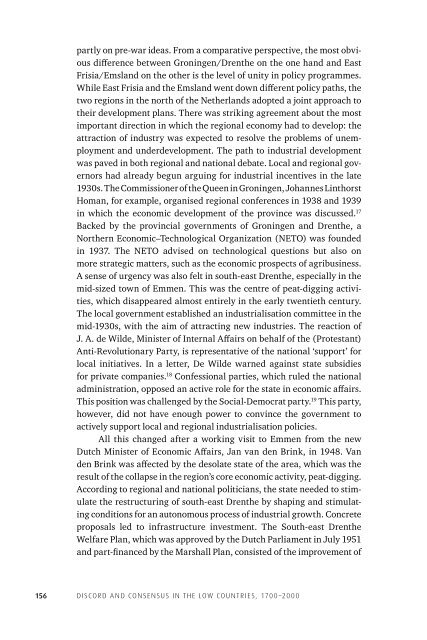Discord Consensus
7aze300jFJo
7aze300jFJo
Create successful ePaper yourself
Turn your PDF publications into a flip-book with our unique Google optimized e-Paper software.
partly on pre-war ideas. From a comparative perspective, the most obvious<br />
difference between Groningen/Drenthe on the one hand and East<br />
Frisia/Emsland on the other is the level of unity in policy programmes.<br />
While East Frisia and the Emsland went down different policy paths, the<br />
two regions in the north of the Netherlands adopted a joint approach to<br />
their development plans. There was striking agreement about the most<br />
important direction in which the regional economy had to develop: the<br />
attraction of industry was expected to resolve the problems of unemployment<br />
and underdevelopment. The path to industrial development<br />
was paved in both regional and national debate. Local and regional governors<br />
had already begun arguing for industrial incentives in the late<br />
1930s. The Commissioner of the Queen in Groningen, Johannes Linthorst<br />
Homan, for example, organised regional conferences in 1938 and 1939<br />
in which the economic development of the province was discussed. 17<br />
Backed by the provincial governments of Groningen and Drenthe, a<br />
Northern Economic–Technological Organization (NETO) was founded<br />
in 1937. The NETO advised on technological questions but also on<br />
more strategic matters, such as the economic prospects of agribusiness.<br />
A sense of urgency was also felt in south-east Drenthe, especially in the<br />
mid-sized town of Emmen. This was the centre of peat-digging activities,<br />
which disappeared almost entirely in the early twentieth century.<br />
The local government established an industrialisation committee in the<br />
mid-1930s, with the aim of attracting new industries. The reaction of<br />
J. A. de Wilde, Minister of Internal Affairs on behalf of the (Protestant)<br />
Anti-Revolutionary Party, is representative of the national ‘support’ for<br />
local initiatives. In a letter, De Wilde warned against state subsidies<br />
for private companies. 18 Confessional parties, which ruled the national<br />
administration, opposed an active role for the state in economic affairs.<br />
This position was challenged by the Social-Democrat party. 19 This party,<br />
however, did not have enough power to convince the government to<br />
actively support local and regional industrialisation policies.<br />
All this changed after a working visit to Emmen from the new<br />
Dutch Minister of Economic Affairs, Jan van den Brink, in 1948. Van<br />
den Brink was affected by the desolate state of the area, which was the<br />
result of the collapse in the region’s core economic activity, peat-digging.<br />
According to regional and national politicians, the state needed to stimulate<br />
the restructuring of south-east Drenthe by shaping and stimulating<br />
conditions for an autonomous process of industrial growth. Concrete<br />
proposals led to infrastructure investment. The South-east Drenthe<br />
Welfare Plan, which was approved by the Dutch Parliament in July 1951<br />
and part-financed by the Marshall Plan, consisted of the improvement of<br />
156<br />
DISCORD AND CONSENSUS IN THE LOW COUNTRIES, 1700–2000


